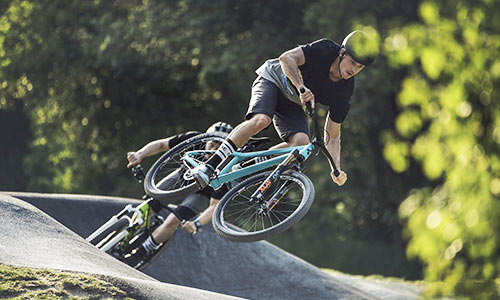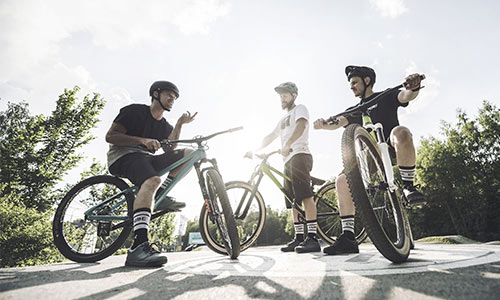BMX bikes are designed for tricks, jumps and turns, or more precisely for bicycle acrobatics, because all the stunts performed on them involve sophisticated maneuvers and have little to do with ordinary cycling. That's why BMX bikes are specially designed for extreme demands and are unsuitable for riding on paved roads. The compact construction makes these bikes extremely maneuverable, and they can be purchased for as little as 300 euros. Professionals are also happy to spend around 1000 euros on their BMX.
Flatland, race, street, park, dirt and vert
Race describes the fast biking over hill and dale on specially designed tracks – just like motocross. This is the best way to compare one form of BMX sport with another, since it is ultimately where it originated: fascinated by motocross, a few young people once started to imitate the motorsport with their bikes, thereby laying the foundation for those exciting disciplines that now also attract large crowds of spectators to European championships. Challenging tracks are mastered, which are peppered with obstacles such as tight concrete curves and steep hills..
Once upon a time, German riders were among the best, but unfortunately their successes have waned. Nevertheless, we very much hope that our riders will be able to match and even top their former performances, because the colorful freestyle sport remains unique. For example, women and men can compete together and children as young as five can take part – what other sport offers something similar?
In 2008, BMX athletes were allowed to take part in the "BMX Race" discipline at the Olympic Games for the first time – proof of the great popularity and, above all, of the requirement for the highest level of skill on the part of the riders, making it worthy of an Olympic event.
Freestyle
As the name suggests, freestyle refers to freer and more creative variants of BMX cycling. The generic term "freestyle" is split into flatland, street, park, dirt and vert, which gives a quick overview. In dirt jumping, jumps and associated tricks are performed in the air. Jumps can be over ten meters, which illustrates how high the material demands on the bikes are. In the park, a limited area is used that is specially designed for BMX tricks. Obstacles such as ramps and curved sections are used to perform tricks as spectacularly as possible.
Flatland is best compared to a dance on the bike, for which the grind bars, so-called pegs, are attached to the rear and front wheels. Combinations of tricks are performed, sophisticated acrobatics that are more reminiscent of breakdancing. This very popular sport and the associated competitions require years of training and an unwavering grit on the part of the rider, who must not shy away from either maximum concentration or falls. As the description above suggests, flatland in particular involves a slightly modified form of the typical BMX bike. Not only pegs are needed, but also a shortened wheelbase and stem, as well as an extended seat post.
Street: Street BMXers use obstacles from our everyday environment for their tricks, tackling everything from railings to walls – in fact, anything that comes in front of their wheels and is even remotely rideable... Sportiness and creativity are equally essential.
Vert: The vert bikers simply use the halfpipes of our skateboarders, similar to the "Park" category, to complete them as impressively as possible.

Only the best for our true bike artists
It goes without saying that jumps of up to 10 meters and the variety of tricks and stunts place special demands on all bicycle components. Up to four-crossed spokes are just as much a feature of BMX bikes as U-brakes and large, stable pedals. In general, the focus is on a compact design, with a stable frame providing the foundation. If you have long legs, an extended top tube is particularly suitable, because when performing tricky tricks, it is crucial that your own knees never get in the way..
Special features and characteristics
Due to the demands placed on them, freestyle bikes have special features such as a 360° rotor and the pegs already mentioned. The length of the top tube is crucial for the appropriate riding style.
The sturdy frame must reliably absorb heavy braking and steering forces, but that's not all: all the other components must also impress with extreme stability. A freestyle biker needs full control, no matter what maneuver they are performing. Some of these are very daring, which illustrates how unshakably a BMX rider must trust their vehicle. For many tricks and stunts, it is essential to maintain your balance, which is why a balanced frame geometry is particularly important for BMX bikes. After spending many meters in the air, this can make the difference between success and a hard crash, because every extra pound makes itself felt.
A BMX rider not only expects a lot of fun with his racing machine, but also maximum stability and functionality. When the handlebars feel like extended arms and a harmonious and intuitive riding experience sets in, the rider can take on any challenge. So, with our bikes, we don't just sell quality, but courage. Rider and bike can become one, and the result of it all is what we get to marvel at: high-level riding skills, peppered with a wide variety of maneuvers, sensational jumps and inspiring tricks.
We love BMX bikes because they are something very special – as special as their riders. As resilient and stable as a tank, as resilient as a rock and yet as agile and nimble as a squirrel... Only freestyle bikes can combine completely opposing properties! Take on the next set of stairs, a bench or a curb: every obstacle becomes another victory for you, a new step on your personal podium..
Master races over hills and dirt, outpace the competition and break the mold: with our freestylers from Scott and Cube!




